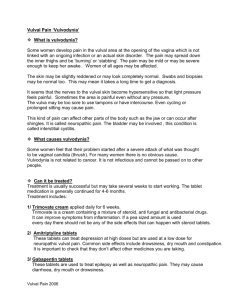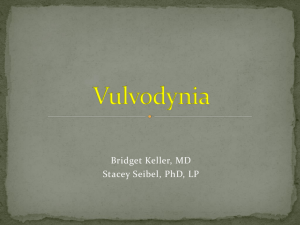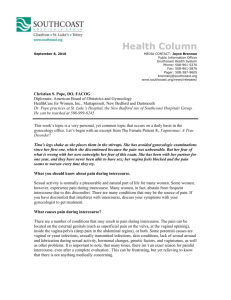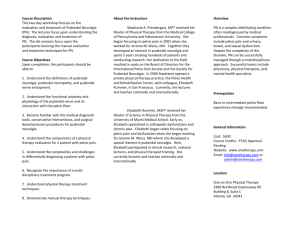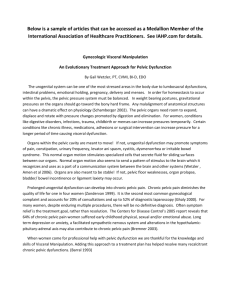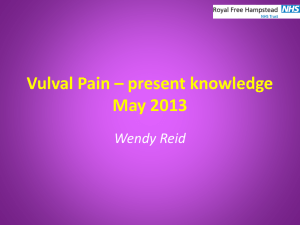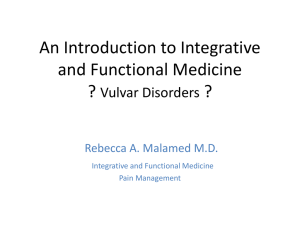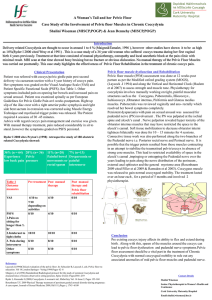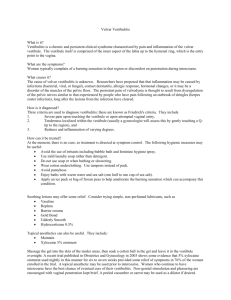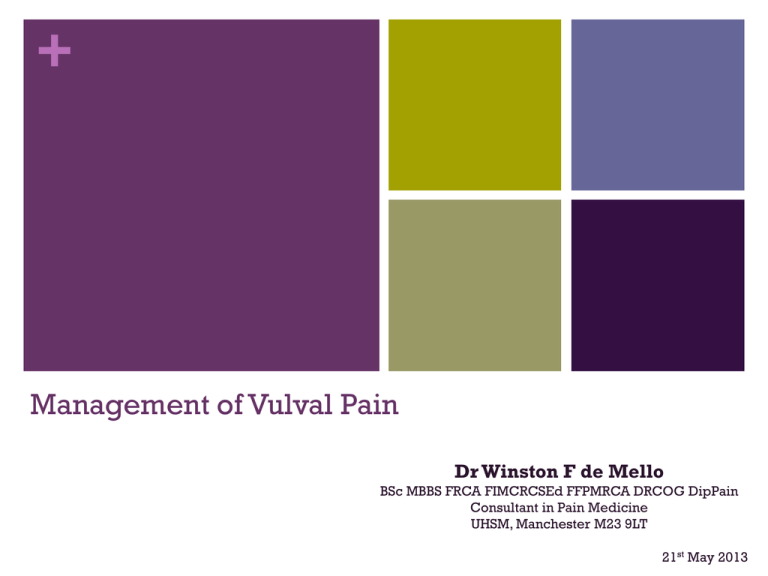
+
Management of Vulval Pain
Dr Winston F de Mello
BSc MBBS FRCA FIMCRCSEd FFPMRCA DRCOG DipPain
Consultant in Pain Medicine
UHSM, Manchester M23 9LT
21st May 2013
+
Pain
“An
unpleasant sensory and emotional
experience associated with actual or
potential tissue damage or described in
terms of such damage.”
(IASP, 1979)
“What
a patient says hurts.”
(McCaffery, 1988)
+
Physiology of Pain
Referral
Pathways
:
+
Complementary
Therapies
Dermatologist
Gynaecologist
Patient
Pain
Clinic
GP
Urologist
Gastroenterologist
GI Surgeons
Private Sector
Internet
Support Groups
Orthopaedic Surgeon
+
Definition of vulvodynia:
Vulval
discomfort ( often burning) in the
absence of relevant visible findings or
specific clinically identified neurological
disorder
Classification:
ANATOMY
PATHOPHYSIOLOGY
Focal vulvodynia
Provoked
Generalised vulvodynia
Unprovoked
Hemi-vulvodynia
Clitorodynia
+
Onset and initial findings:
Most
prevalence between 18 and 25 years but
4% between 45 -54 years and another 4%
aged 55-64 years
Seven
times more likely to report difficulty and pain
with first tampon use
Evaluate hymen and the levator ani
50%
the pain limited sexual intercourse
+ Associated features:
MEDICAL
SEXUAL
Candida infection
Dyspareunia
Vulvar dystrophies
Loss of libido
Neoplasms
Vaginal dryness
Contact dermatitis
Orgasmic difficulty
Hormonally induced atrophy
Sexual aversion
Painful bladder syndrome
Endometriosis
Irritable bowel syndrome
Fibromyalgia
Headache
Pudendal neuropathy, MS
MSK referred pain
Surgery
Radiotherapy
+
Impact of vulvodynia:
PHYSICAL:
PSYCHOSEXUAL:
SOCIETAL
+
Chronic pain consultation:
+ Individual Variation
VULVODYNIA
Psychological Impact
Depression/Anxiety
Loss of Esteem
Psychiatric Illness
Psychological Predisposition
History
Personality
Tolerance
Sexual
Libido
Arousal
Orgasm
Functional
Occupation
Finances
Societal
+
Targeted physical examination:
burning, irritation, stinging, raw feeling, crawling or pain down there”
But no itching!
Vulvar examination:
Pelvic floor
evaluation:
Vaginal inspection:
+
Investigations:
Differential diagnosis:
+
CAUTION:
Every therapy works sometime of the time for
some of the people !
+
Therapeutic Choices
Bio-medical v Bio-psycho-social approach
Surgery
Nerve blocks
Psychology
Drugs
Physiotherapy
Non-Drug
+
Non-Drugs
Explanation
Exercise
Distraction
Physiotherapy
Psychotherapy
TENS
Hypnosis
Mirrors
Counselling
Education
Biofeedback
Peer Support
Groups
Prayer
Relaxation
Imagery
Reassurance
Cling Film
Heat/Cold
Massage
Pressure
Vibration
+
Drugs
NSAID/Coxib
LA
Steroids
Opioids
Adjuvants:
Anti-Depressants
Anti-Convulsants
+
Opioids
Tolerance - Chronic use leads to decline in potency
Dependence – Physiological “cold turkey”
Addiction – Sociopathic or criminal behaviour
Problems
1.
Respiratory Depression
2.
Constipation
3.
Endocrine dysfunction
4.
Itch
5.
Cognitive dysfunction
6.
Reduction in immunity
Types
Codeine
Tramadol
Morphine
Oxycodone
Fentanyl
Buprenorphine
Tapentadol
+
Treatment of vulvodynia:
Reduction of
triggers and irritating stimuli
Reduction in
pain
Treating
pelvic floor dysfunction
Treating
psychosexual ramifications
Reduction
of
triggers:
+
Avoid vulval irritants
Adequate water soluble lubrication for intercourse
Apply ice pack, rinse with cool water post coitus
All white cotton underwear
Loose fitting clothes
Use approved intimate detergents
Use soft white unscented toilet paper
Avoid shampoo
Avoid scented soaps
Prevent constipation
Avoid exercises that put direct pressure or friction
Use 100% cotton tampons
+
Reduction of pain:
Topical lidocaine ointment/gel
Topical estradiol
TENS
TCA
SNRI
Gabapentin/Pregabalin
Trigger point injection
Pudendal nerve block
Vestibulectomy
Start low, go slow and don’t stop abruptly!
+
Treatment of pelvic floor
dysfunction:
Pelvic floor
exercises
External/internal
Trigger
soft tissue self massage
point pressure
Biofeedback
Use
of vaginal trainers/dilators
+
Treatment of psychosexual
ramifications:
Counselling
Sex therapy
Cognitive
– behavioural therapy
Psychotherapy
Invasive techniques:
LOCAL ANAESTHETIC + STEROID INFILTRATION:
PUDENDAL NERVE BLOCK:
OTHER BLOCKS:
+ Summary of BSSVD guidelines for the
management of vulvodynia. Mandal et al (2010)
1.
Take an adequate history
2.
Take a sexual history if there is dyspareunia
3.
Diagnosis is a clinical one
4.
Take an MultiDisciplinaryTeam (MDT) approach
5.
Combine treatments
6.
Give an adequate explanation
7.
Caution with topical agents
8.
Nortriptyline/Amitriptyline +/- Gabapentin/Pregabalin
9.
Surgical excision is sometimes indicated
10.
Identify pelvic floor dysfunction if there is sex related pain
11.
Acupuncture is unproven but may help some patients
12.
Injections may help
+ So Why is Pain Control Difficult?
Time & expertise (education)
Managing expectations
Co-existent morbidity
Concurrent medications/analgesics/allergies/drug side effects and
interactions
Age related changes
Individual response to pain
Difficulties in assessing pain
Cognitive impairment
Opiophobia
Costs
Poor attitude to suffering
Cultural factors
Conclusion:
+
Vulval
pain is commoner than we think
Strive
for a multidisciplinary approach
Don’t
go looking for a cure; concentrate on function
Pain
and suffering are horrible twins!
+
Thank you for your attention!
wdemello@uhsm.nhs.uk
pelvic.dynia@gmail.com
Acknowledgement to patients and colleagues
for all their contributions to our Pelvic Pain Service at UHSM.

